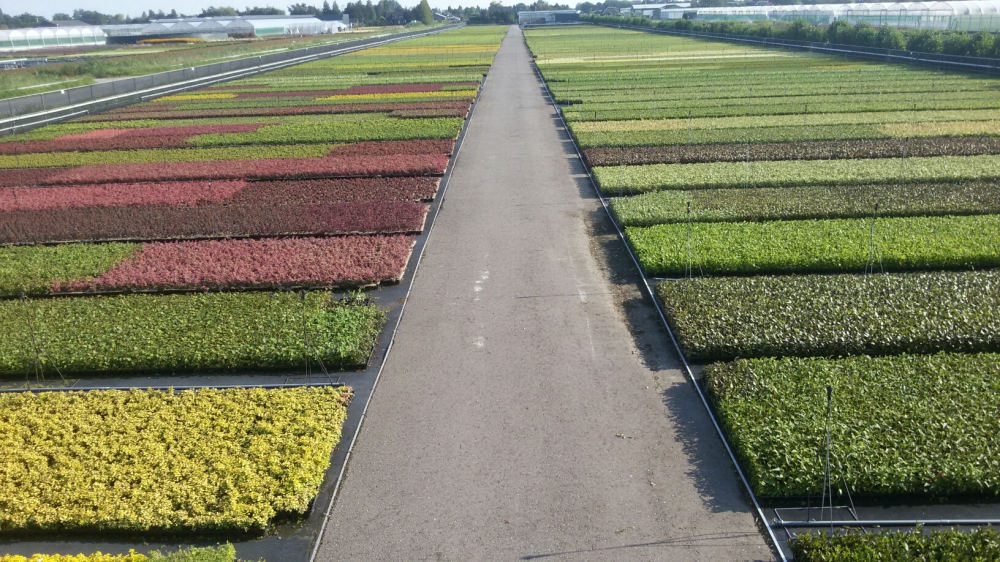- HOME >
- NIEUWS >
- Cultivation 12-09-2024
Ornamental shrubs in cultivation trays

Boomkwekerij M.G. de Boer cv will be present again at this year's edition of trade fair GrootGroenPlus, to promote their product. The company grows a wide range of ornamental shrubs in cultivation trays.
Source: Heidi Peters
The plant material is potted as cuttings in a cultivation tray (18-cell – P9 size) between May and July, after which the cuttings are carefully tended until they become healthy plants. Soon, the cutting develops into a compact, bushy plant with a well-rooted clump. "This plant then forms a good basis for our fellow growers who buy our product and grow it in a larger pot until it becomes a healthy, full, and beautiful shrub, or for the landscapers who use them for planting," says Chiel de Boer.
1 million plants
He continues: "We grow deciduous ornamental shrubs. On our 1.3-hectare container field and 1,000 square meters of glasshouses, we produce over 1 million plants annually. We have around two hundred cultivars, including quite a few licensed varieties. Examples of species we grow include Cornus, Deutzia, Forsythia, Hydrangea, Philadelphus, Potentilla, Spiraea, Syringa, and Weigela. The cutting material we use as a base comes from renowned cutting suppliers in the Netherlands.
Cultivation trays
The plant material from M.G. de Boer is grown in an 18-cell cultivation tray of P9 size. "We intentionally chose a cultivation tray because it makes handling the plants at the tree nursery easier. This allowed us to make significant strides in mechanisation. Working with cultivation trays is not only more efficient for us but also for the buyers, our customers. Instead of handling eighteen P9 pots separately, they can handle all eighteen plants in one go; this saves a lot of time. Processing is faster, so customers can process their supplies more quickly."
Production during the growing season
During the growing season, the focus is on cultivating a compact plant that is uniform in size. Through careful fertilisation and repeated pruning, a bushy, well-branched plant with a nicely rooted clump is achieved. This creates high-quality starting material for the customer. The pruning machine is custom-made for the beds and can easily be operated alone. The pruned material is collected directly in a collection bin. "What adds significant value is that for several years now we have covered all cultivation trays with a cover sheet, which results in an 80 per cent weed reduction. We use a weed collector to remove any emerging weeds during the growing season. The use of cover sheets has also almost eliminated moss from the tree nursery. This growing season, we are testing covering with white foil instead of black to keep the soil temperature lower."
Sales
The plant material from this tree nursery primarily goes to other tree nurseries both domestically and internationally. They grow the plants further in 3- or 5-litre pots. Some of the plants are sent through mail-order companies to private customers. Landscapers also use M.G. de Boer’s products for planting. The assortment is frost-resistant, making it suitable for export to Eastern and Northern Europe. The ornamental shrubs are delivered in cultivation trays and the plant material is available year-round. De Boer: "Domestic customers usually request delivery on CC trolleys. The loading is 5 cultivation trays per layer (90 plants per layer), so a full CC trolley with a maximum of 10 trays is good for 900 plants. For export, we often deliver in (steamed) pallet boxes (about 800 to 1000 plants per box)."
Sustainable use of energy
All internal transport is done with an electric forklift, including potting in the spring and processing the plants during delivery. The forklift has a lithium battery that can be charged indefinitely. This is done during breaks, so the forklift can run all day. The energy for this is provided by the solar panels on the barn.
Sustainable and green cultivation
M.G. de Boer cv has been a member of MPS since 2019 and the tree nursery has been continuously A+-certified since then. "By using MPS, we gain good insight into fertiliser consumption," says De Boer. "We try to minimise the use of crop protection agents. The cover sheets help with that, of course. And... it's also nice to mention that we have a natural bank on one side of the nursery, which has been kept clean by a flock of chickens since this year."